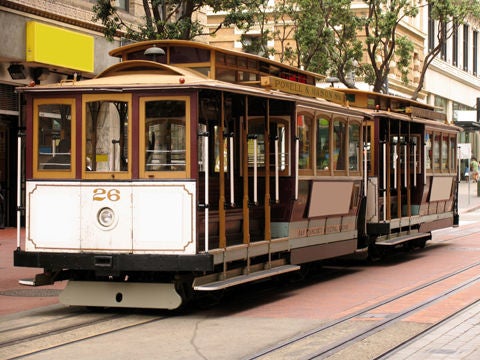April Overall

A lesson from your grandpa: “You’ve got it too easy, whippersnapper. When I was your age, I trekked uphill in the snow for 10 kilometres just to get to school!” With modern-day conveniences at our suburban doorstep, the idea might sound outlandish, but perhaps we should stop and take a cue from our elders. Over the last 70 years, people have swapped walking and streetcars for cars and moved from the city to the suburbs. This seemingly innocent trend, urban sprawl, is taking our country’s landscape hostage – all for the sake of a quick buck.
A Streetcar Named Desire
In the 1930s, people generally lived a hop, skip and a jump away from their work, stores and schools. Electric streetcars were the transportation of choice and zipped around the city, faster than today’s buses. Country dwellers rode interurbans, which were streetcars that started off on city streets but travelled to the country on separate tracks. These interurbans reached higher speeds than we use on freeways today. Life was good.
Baby You Can Drive My Car
But the automobile and gasoline companies didn’t think so. Was there room for both streetcars and automobiles in cities? Not in their minds. In the U.S., gas and automobile corporations bought out the streetcar systems and swapped streetcars for buses, which the automobile companies manufactured. While public transportation in Canada was publically owned and couldn’t be bought out, these same companies put enough pressure on governments that the tracks were removed and buses flooded the streets (buses that, of course, were manufactured by automobile companies).
Cars followed suit. And while citizens relished in their newfound autonomous mobility, the suburbs exploded. Today, over 51 per cent of Canadians live in the ever expanding urban areas of B.C.’s Lower Mainland and southern Vancouver Island; Toronto’s Golden Horseshoe, the Edmonton-Calgary corridor and Greater Montreal. Between 1996 and 2001, these areas grew 7.6 per cent, while the rest of the nation grew only 0.5 per cent.
On the heels of World War II, city planning revolved around automobiles. As narrow streets couldn’t accommodate the sheer number of cars inundating the streets, cities expanded roads and shrank sidewalks, created one-way streets, nixed parking on streets during busy hours and built parking lots. Moreover, traffic engineers suggested that cities create limited access highways, like Ontario’s 401, in order to move people more quickly from the city to adjoining suburbs. Today, our roads, expressways and highways take up approximately five times the amount of land we’d need for public transportation.
And with such low density development, a result of irresponsible expansion beyond the urban centre, urban sprawl was born.
The Cost of Keeping Up with the Joneses
With hordes of people flocking to the suburbs, cities have to set up and maintain water and waste systems, make natural gas and electricity available, and offer solid waste and recycling pick-up over long distances. Moreover, the daily commute releases fossil fuels into the atmosphere, leading to air pollution and contributing to climate change.
A Warming Nation
Approximately 25 per cent of the greenhouse gas emissions that lead to climate change are from transportation. And nearly two-thirds of emissions from cars and trucks are released in urban settings. The more cities expand, the more GHG levels climb.
Murky Waters
When suburban developments, parking lots, driveways, roads, lawns and sewer lines take the place of forests, rainwater can’t seep into the ground to renew groundwater aquifers. As a result, water collects on paved surfaces and creates runoff. According to the U.S. Natural Resources Defense Council, parking lots generate approximately 16 times more runoff than meadows. And this runoff is often filled with all kinds of hazardous chemicals like oil, grease, and other chemicals, which drain into sewers and eventually into our country’s rivers, lakes and oceans. All these chemicals create quite a stir in aquatic habitats, changing them and even destroying them. Development has destroyed nearly 80 per cent of Ontario’s wetlands since European settlement.
Wildlife Goes Homeless
Urban sprawl is the largest threat to the forests and wetlands near our cities. Before European settlement, 90 per cent of Southern Ontario was forest. But due to urban sprawl, only 20 per cent of the same area is forest. The roads we build fragment habitat, alter how predators and prey interact and welcome invasive species into new territories. Moreover, as development makes more homes for humans, other species are robbed of their homes, forcing them to adapt to human habitat.
While some species drop in number, tarnishing the range of genetic diversity, others that are rare or endangered are continuously threatened by extinction. According to Environment Canada, nearly half of Canada’s threatened or endangered species live in the Quebec City-Windsor corridor, but so does nearly half of Canada’s population. Is there room for us all? Not if we keep building.
